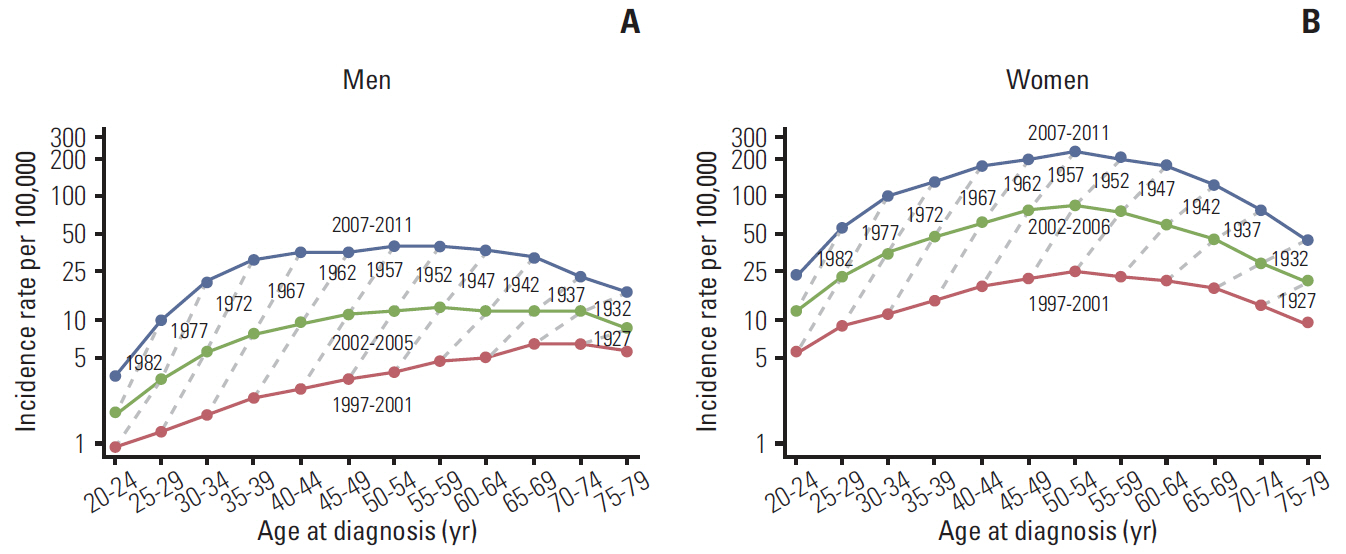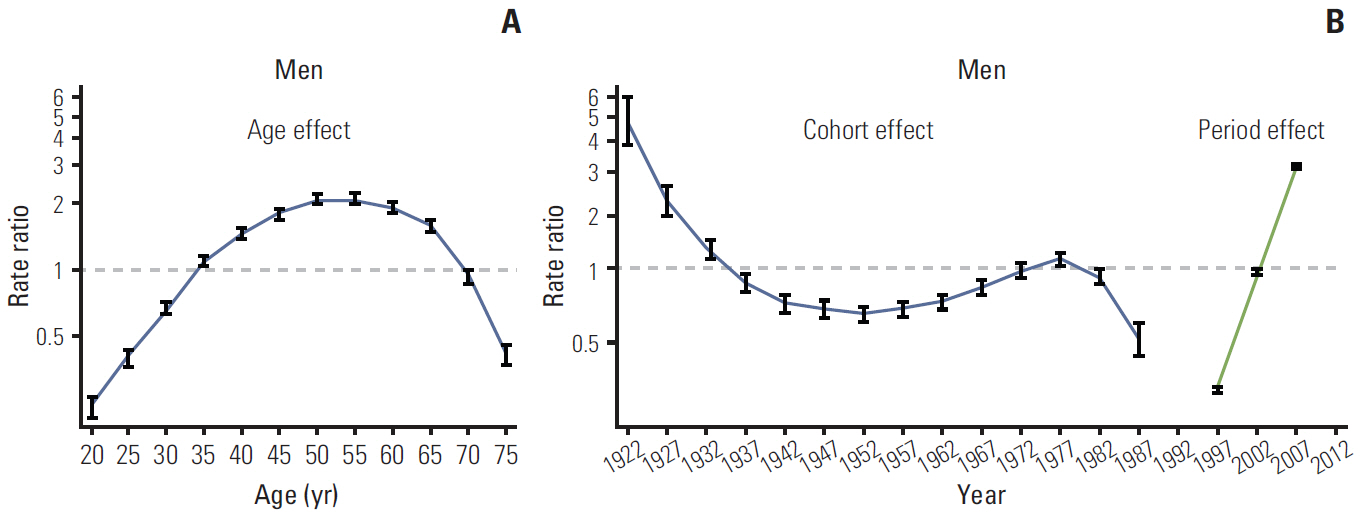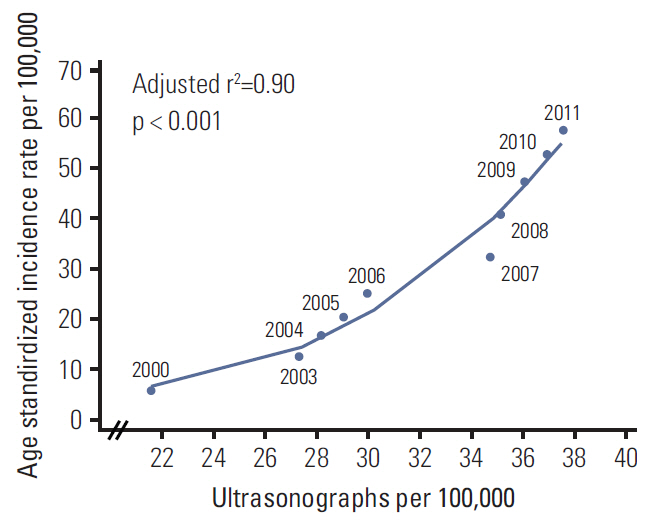Age-Period-Cohort Analysis of Thyroid Cancer Incidence in Korea
- Affiliations
-
- 1The Korea Central Cancer Registry, National Cancer Center, Goyang, Korea. ara@ncc.re.kr
- 2Molecular Epidemiology Branch, Research Institute, National Cancer Center, Goyang, Korea.
- KMID: 2148484
- DOI: http://doi.org/10.4143/crt.2014.110
Abstract
- PURPOSE
South Korea has the highest incidence rate of thyroid cancer in the world, and the incidence rate continues to increase. The aim of this study was to determine the age-period-cohort effects on the incidence of thyroid cancer in Korea.
MATERIALS AND METHODS
Using the Korean National Cancer registry database, age-standardized incidence rates and annual percent changes (APCs) in thyroid cancer according to sex and histologic type were analyzed between 1997 and 2011. Age-period-cohort models were applied using an intrinsic estimator method according to sex.
RESULTS
In both men and women, the incidence of thyroid cancer showed a sharp increase from 1997 through 2011. Among the histologic types, papillary carcinoma showed the greatest increase, with APCs of 25.1% (95% confidence interval [CI], 22.7% to 27.5%) in men and 23.7% (95% CI, 21.9% to 25.5%) in women, whereas anaplastic carcinoma did not show a significant increase in either sex. An increase in overall thyroid cancer incidence over time was observed in all birth cohorts. An age-period-cohort model indicated a steeply increasing period effect, which increased prominently from 1997 to 2011 in both men and women. The age effect showed an inverted U-shaped trend. The cohort effect tended to show a slight increase or remain constant from 1952 to 1977, followed by a decrease.
CONCLUSION
The period effect can explain the sharp increase in thyroid cancer incidence, strongly suggesting the role of thyroid screening.
Keyword
MeSH Terms
Figure
Cited by 8 articles
-
Recent Updates on the Management of Medullary Thyroid Carcinoma
Bo Hyun Kim, In Joo Kim
Endocrinol Metab. 2016;31(3):392-399. doi: 10.3803/EnM.2016.31.3.392.Importance of Regular Follow-Up Examination during Active Surveillance: a Case of Anaplastic Transformation of Papillary Thyroid Microcarcinoma
Jin Seo Kim, Han Ju Moon, Jung Suk Han, Min Joo Kim
Int J Thyroidol. 2016;9(2):185-189. doi: 10.11106/ijt.2016.9.2.185.Risk Factors for Thyroid Cancer: A Hospital-Based Case-Control Study in Korean Adults
Seung-Kwon Myung, Chan Wha Lee, Jeonghee Lee, Jeongseon Kim, Hyeon Suk Kim
Cancer Res Treat. 2017;49(1):70-78. doi: 10.4143/crt.2015.310.Proteomic Biomarkers for Bisphenol A–Early Exposure and Women’s Thyroid Cancer
Ho-Sun Lee, Yunkyeong Kang, Kyung Tae, Gyu-Un Bae, Jong Y. Park, Yoon Hee Cho, Mihi Yang
Cancer Res Treat. 2018;50(1):111-117. doi: 10.4143/crt.2017.001.Changes in the Diagnostic Efficiency of Thyroid Fine-Needle Aspiration Biopsy during the Era of Increased Thyroid Cancer Screening in Korea
Young Ki Lee, Kyeong Hye Park, Young Duk Song, Taemi Youk, Joo Young Nam, Sun Ok Song, Dong Yeob Shin, Eun Jig Lee
Cancer Res Treat. 2019;51(4):1430-1436. doi: 10.4143/crt.2018.534.Trends in the Diagnosis and Treatment of Patients with Medullary Thyroid Carcinoma in Korea
Hwa Young Ahn, Jae Eun Chae, Hyemi Moon, Junghyun Noh, Young Joo Park, Sin Gon Kim
Endocrinol Metab. 2020;35(4):811-819. doi: 10.3803/EnM.2020.709.Current Guidelines for Management of Medullary Thyroid Carcinoma
Mijin Kim, Bo Hyun Kim
Endocrinol Metab. 2021;36(3):514-524. doi: 10.3803/EnM.2021.1082.Seaweed and Iodine Intakes and
SLC5A5 rs77277498 in Relation to Thyroid Cancer
Tung Hoang, Eun Kyung Lee, Jeonghee Lee, Yul Hwangbo, Jeongseon Kim
Endocrinol Metab. 2022;37(3):513-523. doi: 10.3803/EnM.2021.1306.
Reference
-
References
1. Ferlay J, Soerjomataram I, Ervik M, Dikshit R, Eser S, Mathers C, et al. GLOBOCAN 2012 v1.0: cancer incidence and mortality worldwide. IARC Cancer Base No. 10 [Internet]. Lyon:: International Agency for Research on Cancer;2013. [cited 2013 Jan 11]. Available from:http://globocan.iarc.fr/.2. Jung KW, Won YJ, Kong HJ, Oh CM, Seo HG, Lee JS. Cancer statistics in Korea: incidence, mortality, survival and prevalence in 2010. Cancer Res Treat. 2013; 45:1–14.
Article3. Kilfoy BA, Zheng T, Holford TR, Han X, Ward MH, Sjodin A, et al. International patterns and trends in thyroid cancer incidence, 1973-2002. Cancer Causes Control. 2009; 20:525–31.
Article4. Chen AY, Jemal A, Ward EM. Increasing incidence of differentiated thyroid cancer in the United States, 1988-2005. Cancer. 2009; 115:3801–7.
Article5. Hogan AR, Zhuge Y, Perez EA, Koniaris LG, Lew JI, Sola JE. Pediatric thyroid carcinoma: incidence and outcomes in 1753 patients. J Surg Res. 2009; 156:167–72.
Article6. Alston RD, Geraci M, Eden TO, Moran A, Rowan S, Birch JM. Changes in cancer incidence in teenagers and young adults (ages 13 to 24 years) in England 1979-2003. Cancer. 2008; 113:2807–15.
Article7. Liu S, Semenciw R, Ugnat AM, Mao Y. Increasing thyroid cancer incidence in Canada, 1970-1996: time trends and age-period-cohort effects. Br J Cancer. 2001; 85:1335–9.
Article8. Richardson DB. Exposure to ionizing radiation in adulthood and thyroid cancer incidence. Epidemiology. 2009; 20:181–7.
Article9. Peterson E, De P, Nuttall R. BMI, diet and female reproductive factors as risks for thyroid cancer: a systematic review. PLoS One. 2012; 7:e29177.
Article10. Rosenberg PS, Anderson WF. Age-period-cohort models in cancer surveillance research: ready for prime time? Cancer Epidemiol Biomarkers Prev. 2011; 20:1263–8.
Article11. Fritz A, Percy C, Jack A, Shanmugaratnam K, Sobin L, Parkin DM, et al. International classification of diseases for oncology. 3rd ed. Geneva: World Health Organization;2000.12. World Health Organization. International statistical classification of diseases and related health problems. 10th ed. Geneva: World Health Organization;1994.13. Statistics Korea [Internet]. Daejeon: Statistics Korea;2013. [cited 2013 Sep 4]. Available from:http://kosis.kr.14. Oh YH, Lee SH, Shin SY, Jung WJ. A study on analysis of 2000 national medical care resourced and utilization survey. Seoul: Ministry of Health and Welfare;2002.15. Yang Y, Schulhofer‐Wohl S, Fu WJ, Land KC. The intrinsic estimator for age‐period‐cohort analysis: what it is and how to use it. Am J Sociol. 2008; 113:1697–736.
Article16. Mittlbock M, Waldhor T. Adjustments for R2-measures for Poisson regression models. Comput Stat Data Anal. 2000; 34:461–72.17. Davies L, Welch HG. Increasing incidence of thyroid cancer in the United States, 1973-2002. JAMA. 2006; 295:2164–7.
Article18. Cho BY, Choi HS, Park YJ, Lim JA, Ahn HY, Lee EK, et al. Changes in the clinicopathological characteristics and outcomes of thyroid cancer in Korea over the past four decades. Thyroid. 2013; 23:797–804.
Article19. Kim SH, Jung SL, Moon WJ, Park MS, Kim YS, Lee HJ, et al. The prevalence of thyroid nodules and thyroid cancers in the Koreans: The nationwide data analysis of thyroid ultrasonography in 2004. J Korean Thyroid Assoc. 2009; 2:33–7.20. Park S. National epidemiological survey of thyroid cancer incidence in Korea. Goyang: National Cancer Center, Ministry of Health and Welfare;2011.21. Han MA, Choi KS, Lee HY, Kim Y, Jun JK, Park EC. Current status of thyroid cancer screening in Korea: results from a nationwide interview survey. Asian Pac J Cancer Prev. 2011; 12:1657–63.22. Etzioni R, Penson DF, Legler JM, di Tommaso D, Boer R, Gann PH, et al. Overdiagnosis due to prostate-specific antigen screening: lessons from U.S. prostate cancer incidence trends. J Natl Cancer Inst. 2002; 94:981–90.
Article23. Davies L, Welch HG. Thyroid cancer survival in the United States: observational data from 1973 to 2005. Arch Otolaryngol Head Neck Surg. 2010; 136:440–4.24. Kim HM, Park J, Kim HS, Kim DH. Prevalence of the metabolic syndrome in Korean adolescents aged 12-19 years from the Korean National Health and Nutrition Examination Survey 1998 and 2001. Diabetes Res Clin Pract. 2007; 75:111–4.
Article25. Khang YH, Yun SC. Trends in general and abdominal obesity among Korean adults: findings from 1998, 2001, 2005, and 2007 Korea National Health and Nutrition Examination Surveys. J Korean Med Sci. 2010; 25:1582–8.
Article
- Full Text Links
- Actions
-
Cited
- CITED
-
- Close
- Share
- Similar articles
-
- Analysis of Correlation between Thyroid Cancer Incidence and Socioeconomic Status Using 10-year Sample Cohort Database
- Time Trends for Prostate Cancer Incidence from 2003 to 2013 in South Korea: An Age-Period-Cohort Analysis
- The Changes in the Trend of Thyroid Cancer incidence for Korean Population: Consecutive 10 Years Analysis (2004-2013)
- Trends and Age-Period-Cohort Effects on the Incidence and Mortality Rate of Cervical Cancer in Korea
- Thyroid cancer screening






